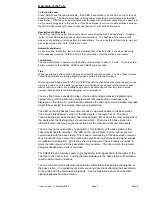
Operation of the Cab:
To turn on the cab:
Press “HORN” and the cab will activate. If the RB01 base station is on, the LED on top of the cab
will start flashing. The LED will not flash until the cab successfully communicates with the RB01
base station. After the cab communicate s with the base stati on normal operations can begin just
as if you were plugged in to the cab bus. If the base station is not on or communications are poor
the LED will light steadily for about 4 seconds then go off with each button press.
Description of LED activity:
The LED on top of the cab will flash every time it communicates with the base stati on. A regular
‘pulse’ of this LED indicates good quality communications. The flashing will become erratic
when you are getting out of range from the base station. You can use this LED activity to ‘map out’
weak signal areas and ‘nulls’ of the layout room.
Automatic shutdown:
As it comes from the factory, the cab will automatically shut itself off after 5 m inutes of inactivity.
If this happens, pressing “HORN” will turn the cab on and normal operations can resume.
Low Battery:
The cab will continue to operate until the battery voltage drops to about 1.5 volts. There is no low
battery warning on the CAB04p, CAB04e and CAB05 engineer cabs.
Tips:
When you press a button on the Cab press and hold for about a second. You don’t have to press
harder than normal but pressing slightly longer results in better performance.
We recommend having several UTP or UTP-DIN panels located around the layout where you can
plug in the cab in case the battery goes dead or conditions such as severe interference cause
loss of control via radio. We usually hang a short cab cable about 2 feet long from a small
number these panels to facilitate plugging in in an emergency.
You may find it more expedient to plug in the cab while doing extensive programming or
system setup. When performing complex tasks that require many messages to be
displayed on the ProCab, communications between the cab and command station may take
longer than expected thus slowing down your programming.
.
The LED on the cab flashes every time it sends a cab status update to the base station.
You can use this flashing to map out the dead spots in the layout room. The cab is
communicating best when the LED has a steady flicker. Move about the room noting where
the spots wher the flashing stops or becomes erratic. Then move the base station to a
different location until you get good reception at at the most important operating spots.
The cab may not operate when you get within 1 foot (300mm) of the base station (other
cabs will still operate normally). The LED on the cab will flicker but the will not seem to
communicate with the base station. This is due to ’overloading’ of the base station receiver.
We’ve found that if you cover the antenna with your hand it will attenuate the signal enough
for reliable communication. Due to the extreme low power of the cab radios we’ve had to
make the radio receivers in the base station very sensitive. This can result in the receiver
being overloaded when a cab is too close.
The CAB04/05 with wireless seems to propogate the radio signal better to the sides of the
cab than to the front or rear. Turning the radio sideways to the base station will sometimes
result in better communications.
The cab will work much better with the antenna vertical rather than pointing the antenna at
the base station. In crowded layout rooms we’ve had good luck attaching the base station
to the ceiling with the antenna pointing down. See the diagram below for how the radio
signal propagates from the antenna.
**Last revised: 21 February 2002
Page 5
RU-4/5








